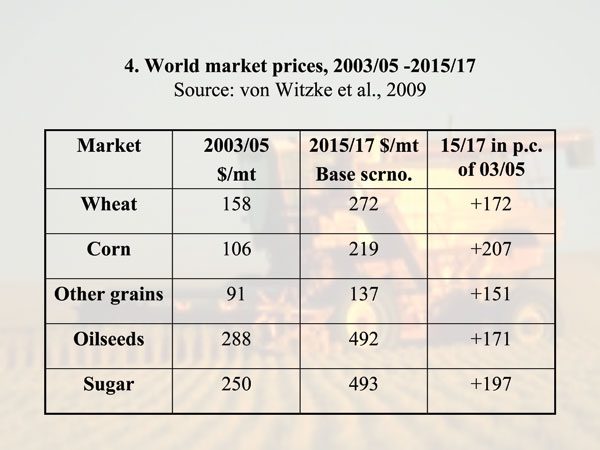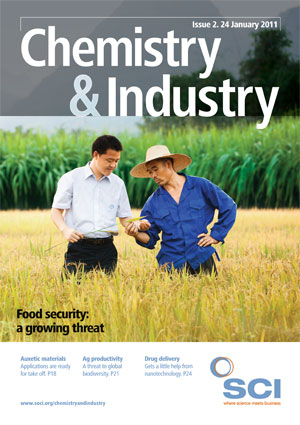Food scientists these days are fond of quoting Thomas Malthus, the 18th century reverend and scholar who once famously proclaimed that ‘the power of population is indefinitely greater than the power in the earth to produce subsistence for man.’ In other words, the world was eventually going to run out of food to feed us all.
Thankfully, this Malthusian catastrophe has thus far been averted by the so-called ‘green revolution’ brought about by fertilisers and pesticides, which permitted scientists and farmers to ramp up productivity to provide more than enough food to feed all 6bn of us on the planet by the year 2000, up from just 1.5bn in 1900. Even if, that is, half of the world ended up with a surfeit of food while at the same time a billion of the poorest people remain malnourished.
But meeting the grand global food challenge over the next half century – when world population is expected to grow to 9bn people by 2050 – promises to be a very different story. To feed all of us by that date, it is estimated that farmers will need to raise productivity by around 70%, as many in the developing world also grow richer and are eating more meat.
Worryingly, however, ‘traditional breeding has already captured much of the productivity potential of crops and livestock,’ said Harald von Witzke at Humboldt University in Berlin, Germany, speaking at a recent SCI meeting: ‘Scanning the agricultural horizon to 2050’ at agri-giant Syngenta’s Jealott’s Hill research station in late November 2010.
During the 1960s-1980s, world agricultural productivity – the amount of food produced per hectare of land – grew by 4%/year. Today that figure is just 1%, von Witzke pointed out, with EUagricultural productivity growing by only 0.6%/ year. And if these low rates of productivity growth are not dramatically improved, then global food shortages together with all of their attendant problems would appear to be inevitable.

Von Witzke lays the blame for this trend with a lack of investment in research in food productivity growth after the EU food surpluses of earlier decades, which prompted payments of subsidies to farmers for idle land, known as 'set aside', under the Common Agricultural Policy (CAP). ‘What is needed,’ von Witzke said, ‘is more agricultural research, but the opposite of that has happened. Agricultural research investment has been cut back significantly in developing countries.’
Food price hikes are another inevitable result. Based on a recent unpublished survey, von Witzke expects that food prices across a range of major food staples including corn, wheat and sugar will rise by between 51% and 107%, compared with 2003/5 prices, by 2015/17 (Table 1) – much higher than the ‘modest’ rises suggested by earlier US Department of Agriculture studies to 2015.
One of the reasons for this dramatic rise is an increase in energy prices, with oil projected to reach $100/bbl by 2015/17, together with a growing demand for biofuels, which will compete with food crops for resources, von Witzke believes. ‘Agriculture is energy intensive – 20-40% of the costs of crop production is energy costs, which will be higher in future. Bioenergy is becoming more competitive, therefore resources will be diverted to energy production, which will in turn push up the price of food.’
World primary energy demand is expected to grow by 36% between 2008 and 2035, according to the International Energy Agency’s World energy outlook 2010, with 93% of that increase from countries outside the OECD. In 2007, meanwhile, the OECD spent $15bn on biofuel subsidies, noted BASF’s head of global public affairs crop protection Rainer von Mielecki, as governments have been pouring money into the development of fast growing energy crops in a bid to find cleaner alternatives to diminishing fossil fuels.
Yet with existing biofuels technology, Mielecki said that 30% of global farmland would be needed by 2030 to replace only 10% of the world’s oil demand. ‘Production of bio-energy should ideally use agricultural by products or land, which is less suitable for food production,’ he says, referring to current initiatives to commercialise second generation biofuels. ‘We need a food first policy.’ According to BASF data, the area of available cropland per head of population has declined from 4300m2 in 1965 to 2200m2 by 2005, and is expected to further reduce to 1800m2 by 2030. ‘At the same time, rising food prices increase the incentives to expand cropland, for example by deforestation,’ Mielecki said, which is in turn ‘a major cause of global warming and a threat to biodiversity.’
Water and nutrients, as well as land, are also in increasingly short supply. The average person requires 2-4 L of drinking water/day, while it takes 200-5000 L of water to produce a person’s daily food requirements, Mielecki continued. By 2025, the UN predicts that two out of three billion people will live in drought or water stressed conditions, while ‘medium or severe water stress will affect large parts of Europe’ by 2030.
This competition for land, food, water and energy, Mielecki warned, portends a ‘looming conflict’, which will be hardest felt in the world’s poorest countries where even small increases in food prices would have damaging consequences and could lead to migration, civil unrest and riots, he said, adding: ‘World food security is high on the political agenda due to the potential political risk’.
Area of concern
Fertilisers to grow more food are yet another area of concern, according to Kent-based environmental consultant Tim Evans. Two thirds of the world’s rock phosphate used to supply the global fertiliser industry are located in Morocco and Western Sahara, and also in China, which has already begun to apply punitive export taxes, Evans pointed out. At current rates of extraction, he warns that today’s rock phosphate mines will be exhausted by the end of this century. ‘The phosphate crisis is on a par with climate change as a threat to the human population,’ Evans said. ‘Living in a world with a 2oC rise in temperature would be unpleasant but we can live. It won’t be possible to live without phosphate.’
Despite its importance, however, initiatives to recycle phosphorus are only just starting to get off the ground. The UK’s first struvite (MgNH4PO4.6H2O) plant will be operational in Slough from 2012 and will recover some of the phosphorus from wastewater for use as fertiliser. Meanwhile, human adults excrete 98% of the phosphorus we ingest in the diet, while both animal manure and human sewage are potential sources, Evans noted. So far, he added, Sweden is the only country to set a national target on is the only country to set a national target on phosphorus recovery; by 2015 it aims to recycle 60% of phosphorus in wastewater.

While research is under way to develop GM cereal crops able to fix nitrogen symbiotically, as do legumes like peas, this won’t solve the problem as it also carries a large yield penalty, Evans remarked.
Others in the sector, however, are more upbeat about the prospects for future development. Only 4% of the world’s biomass production is currently used for food, materials and energy, pointed out David Turley of the National Non-Food Crops Centre in York, UK. Although estimates vary widely, there are considerable amounts of currently under-utilised land that could be put to bio-feedstock production, Turley said, noting that ‘use of all the idle and economically marginal arable and grassland resource [in the UK] has the potential to meet 6.3% of UK power demand (21% of the country’s Renewable Energy Strategy target) or 7.6% of UK heat (63% of the RES target)’. Definitions of under-utilised land are hazy, however, as Turley acknowledged that one person’s unused land may be another person’s nature reserve.
He pointed out that the UK food supply chain currently creates 18-20m t of waste/year, mostly packaging, including an estimated 8m t of food waste. The UK produces about 100m t of digestible waste each year, which could generate up to 7.5% of the renewable energy required in the UK by 2020. Ineos Bio, for example, has recently announced plans to establish Europe’s first municipal waste to bioethanol plant in Teesside, UK, which could be operational by 2012, producing 24,000t/year biofuel and more than 3MW clean electricity.
The pressure on agricultural crops will reduce in the next decade as new technologies come onstream, Turley believes, referring to new second generation processes to make use of cellulosic wastes. Several of these newer processes can accept a wide range of non-crop plant materials as well as crop and forestry byproducts as feedstocks, for example.
Integration of different technologies will also be key to maximising productivity while minimising environmental impacts. Using plants to produce renewable polymers, which can be harnessed to produce bio-energy at the end of their lifetime, he points out, for example, offers an opportunity to deliver significantly higher greenhouse gas savings for each hectare of feedstock.
Time to develop many of these new technologies, though, is running out. If we want to avoid a Malthusian catastrophe a second time, then research to grow productivity gains needs to start yielding results fast.




